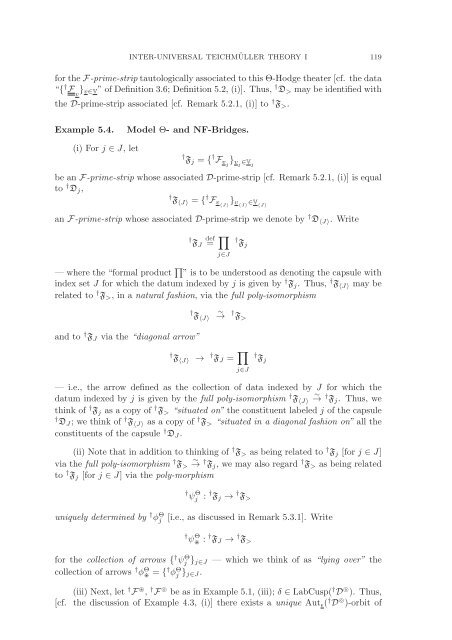Inter-universal Teichmuller Theory I: Construction of Hodge Theaters
Inter-universal Teichmuller Theory I: Construction of Hodge Theaters
Inter-universal Teichmuller Theory I: Construction of Hodge Theaters
Create successful ePaper yourself
Turn your PDF publications into a flip-book with our unique Google optimized e-Paper software.
INTER-UNIVERSAL TEICHMÜLLER THEORY I 119<br />
for the F-prime-strip tautologically associated to this Θ-<strong>Hodge</strong> theater [cf. the data<br />
“{ † F v<br />
} v∈V ” <strong>of</strong> Definition 3.6; Definition 5.2, (i)]. Thus, † D > may be identified with<br />
the D-prime-strip associated [cf. Remark 5.2.1, (i)] to † F > .<br />
Example 5.4.<br />
Model Θ- and NF-Bridges.<br />
(i) For j ∈ J, let<br />
† F j = { † F vj } vj ∈V j<br />
be an F-prime-strip whose associated D-prime-strip [cf. Remark 5.2.1, (i)] is equal<br />
to † D j ,<br />
† F 〈J〉 = { † F v〈J〉 } v〈J〉 ∈V 〈J〉<br />
an F-prime-strip whose associated D-prime-strip we denote by † D 〈J〉 .Write<br />
† F J<br />
def<br />
= ∏ j∈J<br />
† F j<br />
— where the “formal product ∏ ” is to be understood as denoting the capsule with<br />
index set J for which the datum indexed by j is given by † F j .Thus, † F 〈J〉 may be<br />
related to † F > ,inanatural fashion, via the full poly-isomorphism<br />
† F 〈J〉<br />
∼<br />
→ † F ><br />
and to † F J via the “diagonal arrow”<br />
† F 〈J〉 → † F J = ∏ j∈J<br />
† F j<br />
— i.e., the arrow defined as the collection <strong>of</strong> data indexed by J for which the<br />
datum indexed by j is given by the full poly-isomorphism † ∼<br />
F 〈J〉 → † F j . Thus, we<br />
think <strong>of</strong> † F j as a copy <strong>of</strong> † F > “situated on” the constituent labeled j <strong>of</strong> the capsule<br />
† D J ; we think <strong>of</strong> † F 〈J〉 as a copy <strong>of</strong> † F > “situated in a diagonal fashion on” all the<br />
constituents <strong>of</strong> the capsule † D J .<br />
(ii) Note that in addition to thinking <strong>of</strong> † F > as being related to † F j [for j ∈ J]<br />
via the full poly-isomorphism † ∼<br />
F > → † F j , we may also regard † F > as being related<br />
to † F j [for j ∈ J] via the poly-morphism<br />
† ψ Θ j : † F j → † F ><br />
uniquely determined by † φ Θ j<br />
[i.e., as discussed in Remark 5.3.1]. Write<br />
† ψ Θ : † F J → † F ><br />
for the collection <strong>of</strong> arrows { † ψj Θ} j∈J<br />
collection <strong>of</strong> arrows † φ Θ = { † φ Θ j } j∈J.<br />
—whichwethink<strong>of</strong>as“lying over” the<br />
(iii) Next, let † F ⊛ , † F ⊚ be as in Example 5.1, (iii); δ ∈ LabCusp( † D ⊚ ). Thus,<br />
[cf. the discussion <strong>of</strong> Example 4.3, (i)] there exists a unique Aut ɛ ( † D ⊚ )-orbit <strong>of</strong>
















